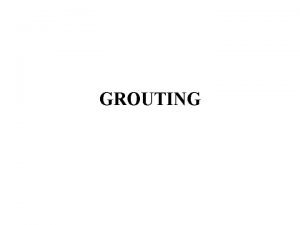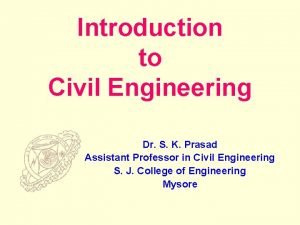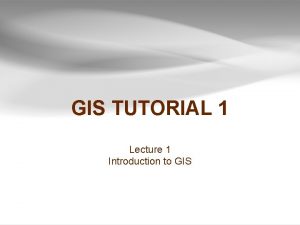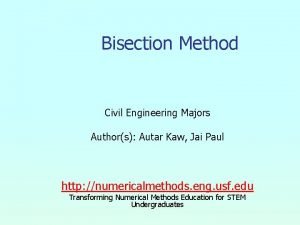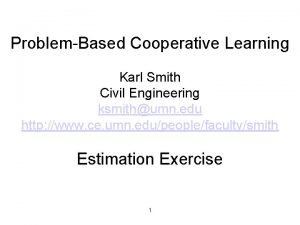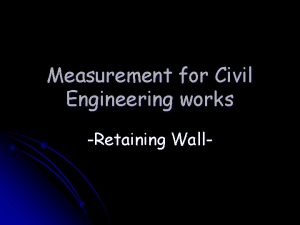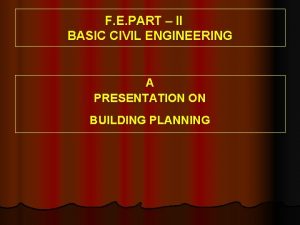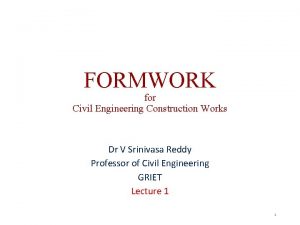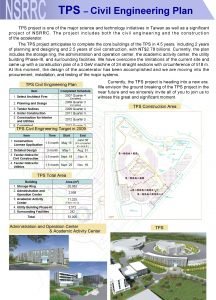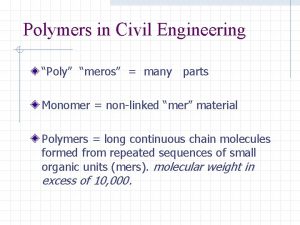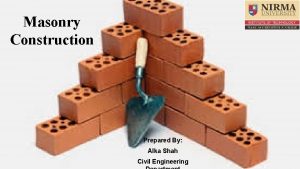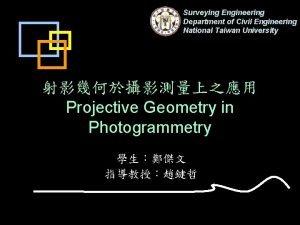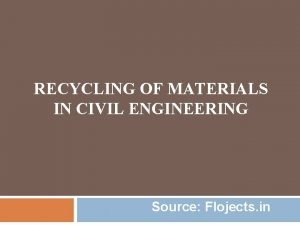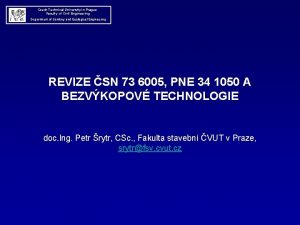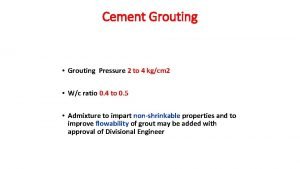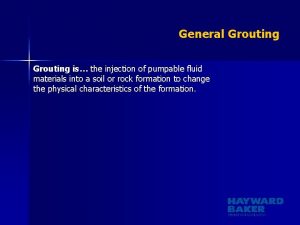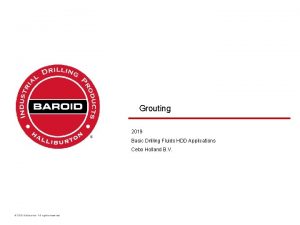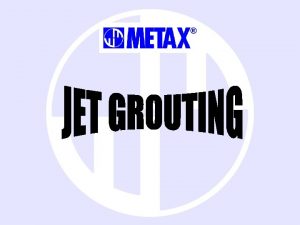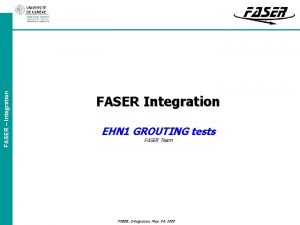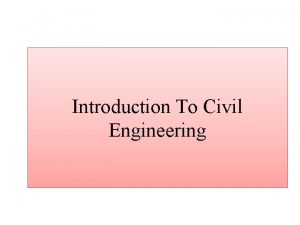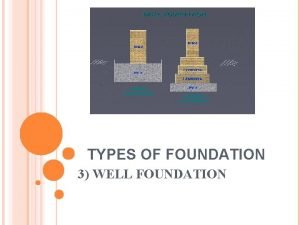Lecture 5 Civil Engineering Practice Foundation Grouting Instructor










































- Slides: 42


Lecture # 5 Civil Engineering Practice Foundation Grouting Instructor: Engr. Dr. Attaullah Shah Department of Civil Engineering Swedish College of Engineering and Technology-Wah Cantt. 2

Grouting • Grout is a construction material used to embed rebars in masonry walls, connect sections of pre-cast concrete, fill voids, and seal joints (like those between tiles). • Grout is generally composed of a mixture of water, cement, sand, often color tint, and sometimes fine gravel (if it is being used to fill the cores of cement blocks). It is applied as a thick liquid and hardens over time, much like mortar. • Initially, its application confines mainly in void filling, water stopping and consolidation. Nowadays, it extends to alleviate settlement of ground caused by basement and tunnel excavation works, to strengthen ground so that it can be used as a structural member or retaining structure in solving geotechnical problems. 3

Grouting • Grouting is the process to inject grout into the ground. Hence, the volume of the ground ready to accept grout is the primary consideration before any other considerations. • GROUT can be defined as a solution, an emulsion or suspension in water, which will harden after a certain time interval. It can be divided into two main groups: • a. Suspension Grout • b. Liquid Grout or Solution Grout. • Suspension grout is a mixture of one or several inert materials like cement, clays etc. suspended in a fluid -- water. According to its dry matter content it is either of the stable or unstable type. suspension grout is a mixture of pure cement with water. • Liquid grout or solution grout consists of chemical products in a solution or an emulsion form and their reagents. The most frequently used products are sodium silicate and certain resins. 4

Use of Grouting in Civil Engineering • Its traceable record can be as early as in the beginning of 1800 s. • In 1802, the idea of improving the bearing capacity under a sluice by the injection of self-hardening cementitious slurry was first introduced • In 1864, Peter Barlow patented a cylindrical one-piece tunnel shield which could fill the annular void left by the tail of the shield with grout. It is the first recorded use cementitious grout in underground construction. • In 1893, the first systematic grouting of rock in the USA as performed at the New Croton Dam, in New York. • In 1960 s, jet grouting technique was developed. • In 1977, first application of compaction grouting for controlling ground movement during construction of the Bolton Hill Tunnel. • In 1995, the first industrial application of the compensation grouting concept was conducted at the construction site of the Jubilee Line Extension Project in London. 5

6

Types of Grouts • Cement-based Grouts: – Cement-based grouts are the most frequently used in both water stopping and strengthening treatment. They are characterized by their water cement ratio and their Total Dry Matter / Water weight ratio. The properties and characteristics of these grouts vary according to the mix proportions used. However, they have the following properties and characteristics in common. • Stability and fluidity according to the dosage of the various components and their quality • Unconfined compressive strength linked to water cement ratio • Durability depending on the quantity and quality of the components • Easy preparation and availability • Ease of use • Relatively low cost mixes 7

• Pure cement grout • It is an unstable grout. However, bleeding can be avoided with water cement ratio less than 0. 67. • Usual mix proportions are from water cement ratio 0. 4 to 1 for grouting. Very high mechanical strength can be attained with this type of grout. • During grouting, cement grains deposit in inter-granular voids or fissures is analogous to a kind of hydraulic filling. • The grout usually undergoes a significant filtration effect. The grain fineness is an important factor fine fissures. 8

Bentonite cement grout It is a stable grout. When bentonite is added to a cement suspension, the effects are: – Obtain a homogeneous colloidal mix with a wide range of viscosity. – Avoid cement sedimentation during grouting. – Decrease the setting time index and separation filtering processes. – Increase the cement binding time. – Improve the penetration in compact type soils – Obtain a wide range of mechanical strength values. – In water stopping, grout will include a lot of bentonite and little cement. In consolidation works, grout will contain a lot of cement and little bentonite. Ideal mixes should be both stable and easy to pump. 9

Grouts with fillers • Fillers are added in order to modify the viscosity of a given grout so as to obtain a low cost product to substitute the cement. The most commonly used fillers are the natural sands and fly ash from thermal power stations. • The term “mortar” is commonly used to specify grouts with fillers that have a high sand content. Adding fillers reduces the grout penetrability, as the fillers are of larger grain sizes. • Grouts with fillers are used when water absorption and/or the size of voids are such that filling becomes essential and when the leaking of grout into adjoining areas should be limited. • In addition, fillers in grout will produce low slump grout with high viscosity for certain grouting purposes. 10

Silicate based grouts • Slicates based grouts are sodium silicate in liquid form diluted and containing a reagent. • Their viscosity changes with time to reach a solid state that is called the “gel”. • They are used in soils with low permeability values such that all suspension grouts cannot penetrate. According to the type of grout used, the gel obtained will be water • Tightness and/or with strength that are temporary or permanent. • When the temperature of a silicate decreases, its viscosity increases very rapidly. This temperature should not fall below 0 degree C in order to eliminate any risks of modification of its properties. 11

Soft gels • It is mainly for water stopping purpose. They are gels with a very low dosage in silicate in which the gelling process is most generally obtained by adding a mineral reagent • Their very low degree of viscosity (close to water) ensures the injection of very fine sand to achieve the water stopping purpose. • Reduction in permeability can be up to 1 x 10 -6 m/s and, in some case even up to 1 x 10 -7 m/s when more lines of grout holes are added. There is also a slight improvement in strength, about 0. 2 MPa. 12

Grout Injection Methods • Different grout injection methods have been developed for different grouting techniques. There are four main injection methods to inject grout into the ground. • Drill Hole Method – A hole is drilled through the pores/voids of the ground. Then grout is pumped via the grouting line into the surrounding ground of a section with the use of single or double packers. • Drill Tool Method – It is a one-stage grouting method by means of the drill casings or rods. There are two injection methods. – A very permeable soil maybe injected during rotary drilling. During the drilling of the grout hole, each time a re-determined distance has been reached the drill rod is withdrawn a certain length and the grout is injected through the drill rod into the section of soil drilled. During each injection the top of the grout hole, a collar is used to seal the gap between the hole and the drill rod. 13

• Grout Pipe Method • Grout pipes are installed in drilled hole for later on gout injection operation. The gaps between the grout pipe and the drilled hole are normally sealed. When compared with above Drill Tool Method, it is more flexible as the drilling plant is not engaged in the grouting operation. • For multiple-stage grouting, the sealed-in sleeve pipe injection method (the tube-à-manchettes method) is used. It allows several successive injections in the same zone. • The method is to place a grout pipe with rubber sleeves into a grout hole, which is kept open by casing or by mud. This pipe is then permanently sealed in with a sleeve grout composed of a bentonite-cement grout. • 14

• Jetting Method • Finally, a different type of injection method, the jet grouting method, is introduced in the 60 s, which has a revolutionary change to the grouting concept so far. • The grout, with the aid of high pressure cutting jets of water or cement grout having a nozzle exit velocity >= 100 m /sec and with air-shrouded cut the soil around the predrilled hole. • The cut soil is rearranged and mixed with the cement grout. The soil cement mix is partly flushed out to the top of the predrilled hole through the annular space between the jet grouting rods and the hole wall. Different shape of such soil cement mix can be produced to suit the geotechnical solution. The cutting distance of the jet varies according to the soil type to be treated, the configuration of the nozzle system, the combination of water, cement and shrouded-air, and can reach as far as 2. 5 m. 15

16

Different Types of Grouting Mechanisms • There are lots of names as far as grouting techniques are concerned. They can be categorized according to their functions, their grout materials used etc. Five major techniques are: • the Rock Fissure Grouting, • TAM Grouting, • Compaction Grouting, • Compensation Grouting and • Jet Grouting. The five selected grouting techniques should have covered the basic mechanisms of all existing grouting techniques. 17

• Rock Fissure Grouting • Rock fissure grouting is the use of a hole drilled through the fissures and joints of a rock mass to allow grout to be injected at close centers vertically and re-injecting, if necessary. • Grouting Mechanism – There is only one grouting mechanism for rock grouting. The following schematic diagrams show is the mechanism for grouting in rock. The grout is injected under pressure through the grout hole drilled into the rock mass to be treated. 18

Application • Rock fissure grouting technique has a long history of application in civil engineering. Its main applications are: • Sealing rock mass underneath and at ends of dams to prevent seepage or leaking of the reservoirs. • Sealing rock mass above and underneath a rock tunnel to prevent water seepage into the excavated tunnel. • Cementing fractured rock mass. Although Rock Fissure Grouting technique can be used to cemented sugar clubs rock formation, like in slope stability projects, its main application is in the field of water stopping, especially in tunnel excavation project. 19

20

• Tube-à- Manchettes (TAM) Grouting • Tube-à-Manchette (TAM) grouting is the use of sleeved perforated pipes in grout holes, soils or completely decomposed rock to allow grout to be injected at close centers vertically, and re-injected, if necessary • Grouting Mechanism – It is a grouting technique for grouting in soil formation only, with partial or complete displacement of in-filling ground water. The pores/voids in between the soil particles are filled with grout under pressure with partial or complete displacement of in-filling ground water. – When the grout has set, the soil mass becomes a matrix of soil particles cemented by the grout. In addition to the sealing purpose, it also changes the property of the soil mass e. g. the strength of the soil mass The most obvious change in ground property by this treatment method is the reduction of permeability. Ground consolidation is also attained, but the increase in strength is limited. For high strength 21 improvement, it will be very expensive.

22

• Application of TAM • Main applications of the TAM grouting technique are: – Sealing soil mass above and underneath a tunnel excavated in soil under compressed air condition. – Sealing soil mass behind the soldier pile wall, pipe pile wall etc. – Sealing “windows” in cofferdams – Consolidation of loose soil mass (cohesion less granular sand) – Sealing underlying soil of dams 23

• Jet grouting is a grout injection that cuts and mixes the soil to be treated with cement or cementitious grout. • With regard to the CUT and MIX grouting mechanism, the soil particles are cut by the grout jetting under high pressure and mixed with it to form a matrix. When the grout set, the matrix is not only impermeable, but also possesses some kind of strength. • The strength of the matrix depends on the grout strength and the degree of soil replacement. 24

• Application • The jet grouting technique is developed in the 1960 s. However, because of its unique properties, it is becoming quite popular in the civil engineering works. Its main applications are: • Grouting of clay / silt soils which is not suitable for TAM grouting technique. • Jet grout wall and roof are used to reinforce tunnel portal excavation works. • Sealing of windows of coffer dams • Used as jet grout raft to reinforce cofferdam to limit its deflection and thus decrease the settlement caused by the excavation works. 25

• Compaction Grouting • Compaction grouting is a single-stage grouting with high strength mortar to the ground to create a grout-bulb at the end of drill pipe. • Grouting Mechanism – A stiff grout with a very low slump is injected under relatively high pressure through pipes or casings into soil. The grout exiting the bottom of the pipe forms a bulb-shaped mass that increases in volume. – Displacement of the soil is produced by the weight of the overburden pushing back against the expanding grout bulb. Thus it densifies the soft, loose, or disturbed soil surrounding the mass. – It can also be used to alleviate settlement problem during the excavation of tunnel or deep basement as the hardened bulb-shaped grout will induce an increase in the soil volume strain to the soil strata and cause heaving of ground at the ground surface. 26

• Application • Compaction grouting is a soil and foundation support improvement system that increases the bearing capacity of soils. • A major advantage of using compaction grouting is that its maximum peak effect is realized in the weakest or softest strata of the infrastructure support. • Its main applications are as follows: • a. Lateral static densification of soils. • b. Lifting and re-leveling roads, bridges, and other existing structures • c. Blocking of flow-path of viscous liquids through stratum layers and rock cracks, voids, and fractures • d. Construction of underpinning • e. The remediation of sinkholes 27

28

Compensation Grouting • Compensation grouting is a grout injection that can ‘compensate’ for stress relief and associated ground settlement. • Grout is injected through grout pipes, which are usually TAM grout pipes, under high pressure into the soil. Fractures in soil are created which are then filled with grout. • The fractures filled with grout will follow the plane with the minor principle stress and formed in layers. • The increase in volume will compact disturbed soil surrounding the mass, will compensate settlement caused by tunnel Excavation works and can be used to lift up settle structures. 29

Grouting Equipment • Percussion Drilling. Percussion drills are operated by air-driven hammers. The best known types are the jackhammer, drifter, and wagon drill. The drill proper consists of a hollow steel rod, fitted with a fixed or detachable bit on one end a shank on the other. • Operation. Percussion drills are used for drilling in rock. The percussion drill does not reciprocate. Its shank fits into and is held loosely in the chuck at the forward end of the machine, where it is struck by a hammerlike piston actuated by compressed air. During drilling the bit remains in close contact with the rock at the bottom of the hole at all times except during the slight rebound caused by impact of the hammer. Drills are provided with a mechanism that causes the drill steel rod to rotate between blows of the hammer. • Cuttings or sludge are removed from the hole by air or water that passes through the machine, down the hollow drill steel rod to the bottom of the hole, and then rises up the hole to the surface. Removal of cuttings by water is preferred for grout-hole drilling but is not mandatory. 30

• Jackhammer drills, due to their light weight, are usually held in position by hand. Drifter-type drills are designed for tripod or bar mounts. • The wagon drill, as commercially available, is comprised of a drill head mounted in leads that are supported on a track-, wheel- , or skidmounted chassis. • Application. Percussion drilling produces acceptable grout holes • and, generally, is the most economical method of drilling shallow holes. This advantage decreases with depth and disappears at depths from 75 to 125 ft depending on the type of rock. In operation, the edges or wings of the bit wear away so that a progressively smaller hole is drilled. Therefore, when pertinent, the specifications should state the minimum acceptable size of grout hole. 31

• Rotary Drilling. Rotary drilling is the process of making a hole by advancing a drilling bit attached to a rotating column of hollow drill pipe. • The drill pipe is turned by a motor at speeds ranging from a few hundred to 3, 000 or more rpm. Pressure on the bit is applied hydraulically or mechanically. Water is forced through the drill pipe to wash cuttings out of the hole. • Drill rigs vary in size from small lightweight machines capable of drilling a few feet holes to several miles in depth. • Small rigs are suitable for grout holes. • A variety of rotary bits are used for various sizes of holes for grouting. 32

33

Grout Mixer • Grout Mixers. Many types of grout mixers have been used, including hand-turned dough mixers, concrete mixers of various sizes, and especially designed grout mixers. Any machine is suitable that has the desired capacity and that mixes the grout mechanically to a uniform consistency. • Two mixers can be arranged to discharge into the same sump to satisfy high capacity requirements. Manual stirring of cement and clay grouts in a tub is not satisfactory except in emergencies. Hand-powered dough mixers are not recommended because of their limited capacity. • (1) Central Valley-type grout mixer, 8 -cu-ft capacity. – During the grouting at several dams of the Central Valley Project, a small, air operated, lightweight grout mixer was needed that could be set up and operated in a 5 - by 7 -ft gallery. 34

35

• Grand Coulee-type grout mixer, 21 -cu-ft capacity. – In the grouting at Hoover Dam, considerable experimenting was done with various equipment for mixing grout. Concrete mixers were first used but were later discarded for the type mixer. • High-speed colloidal-type mixers. High-speed colloidal-type grout mixers are commercially available in both the single - and double –drum types. These mixers are equipped with small centrifugal pumps, which cause the grout to circulate at high speed while being mixed. Particles of cement may be broken and rounded to a significant degree in high-speed mixers. This results in an increase in pumpability and penetrability for Portland-cement grout. In an emergency, grout can be pumped at low pressures into the foundation or other places with the centrifugal pumps of these mixers. • Water meters. – A satisfactory water meter is the single-disk type, size 1 -1/2 in. , and threaded for pipe connection. This type has a 6 -in. vertical register with a long hand that makes one revolution per cubic foot of water and a short hand that indicates 10 cu ft per revolution. For use in grouting, the meter should have a reset knob to set the hands to zero and a direct-reading totalizer. A screen should be provided if sand or rock particles are present in the water supply 36

37

Agitator sumps. – After mixing, grout should be agitated to prevent settlement while it is being pumped. This can be done by pumping the grout into a sump equipped with a stirring blade. – Agitator should have the same capacity as the mixer so that one batch of grout can be pumped while the next batch is being mixed. When emptying the grout from the mixer into the agitator, the grout should pass through a 1/8 -in. -mesh screen to remove pieces of sacks, strings, wire, ties, or other foreign matter that may be dropped into the mixer. • PUMPS. – Pumps for cement grouting should be sufficiently flexible to permit close control of pressure and to provide for a variable rate of injection without clogging of valves and feed lines. With constant speed pumps, special arrangements of the supply piping systems and valves are needed to provide close control of the grouting operation. Constant speed pumps are powered by electric motors or internal-combustion engines. Variable speed pumps are hand operated, steam driven, or air 38 driven.

Grout Agitator 39

• GROUT LINES. • a. General. There are two primary arrangements of piping used to • supply grout from the pump to the hole. The simpler of the two is the single-line system. It consists of a pipe or a hose or a combination of both, extending from the pump to the header at the hole. • The pump speed controls the rate of injection. The second arrangement is the double -line or circulating system. This system has a return line from the header to the grout sump in addition to the pump line of the single -line system. Thus, if the header connection to the hole is closed, grout can be continuously circulated from the grout sump to the pump, through the pump line, through the header, and back to the sump through the return line. While grouting, the amount of grout entering the hole through the header can be varied by opening or closing a valve on the return line without changing pump speed. The double-line system is generally preferred because it permits better control of grouting pressures and allows less 40 material to settle out of the mix to plug the lines

• Hose. – Flexible hose is most commonly used for suction and discharge lines. If the length of the discharge line is such that pipe is necessary, a short length of hose should be provided at the pump discharge and at the connection to the grout header. • Piping. – Black steel pipe and fittings 1 -1/2 in. in diameter are normally suitable for pressure lines ; but where large quantities of grout are to be injected and the supply line is long, it may be desirable to provide a larger size pipe and connection hoses. • Grout Header. – The grout header is usually assembled as a unit in order—that it may be moved from one grout hole to another. The assembly consists of the operating valves, a pressure gage, pipe, and the necessary fittings to attach the header to the hole and to attach the grout supply and return lines. • Pressure Gages. – Reliable pressure gages are essential in pressure grouting. They constitute the principal index to the behavior of the hole and the stresses that are being produced in treated material. 41

Schematic Plan of Grout Plant 42
 Grouting in civil engineering
Grouting in civil engineering Foundation engineering lecture notes
Foundation engineering lecture notes Ipwe udaipur
Ipwe udaipur Suspension grouting
Suspension grouting Low lift grouting
Low lift grouting Civil rights webquest
Civil rights webquest 01:640:244 lecture notes - lecture 15: plat, idah, farad
01:640:244 lecture notes - lecture 15: plat, idah, farad Raft foundation vs pad foundation
Raft foundation vs pad foundation Foundation standard 1 academic foundation
Foundation standard 1 academic foundation Unsw 8621
Unsw 8621 Hse in civil engineering
Hse in civil engineering Risk management in civil engineering
Risk management in civil engineering What is formwork in civil engineering
What is formwork in civil engineering Introduction to civil engineering
Introduction to civil engineering Role of civil engineering
Role of civil engineering Gis applications in civil engineering
Gis applications in civil engineering Czech technical university in prague civil engineering
Czech technical university in prague civil engineering Civil house drawing
Civil house drawing Bisection method application in civil engineering
Bisection method application in civil engineering Umn civil engineering
Umn civil engineering Ndsu civil and industrial engineering building
Ndsu civil and industrial engineering building Mass concrete retaining wall
Mass concrete retaining wall What is roominess in civil engineering
What is roominess in civil engineering Civil engineering applications of ground penetrating radar
Civil engineering applications of ground penetrating radar Idp project for civil engineering
Idp project for civil engineering Civil engineering faculty
Civil engineering faculty Ub course flowsheet
Ub course flowsheet Cuban american civil engineering association
Cuban american civil engineering association Branch of civil engineering
Branch of civil engineering Fc' concrete formula
Fc' concrete formula Rtei
Rtei In civil engineering
In civil engineering Column shuttering work
Column shuttering work Eol jsc nasa gov
Eol jsc nasa gov Tps civil engineering
Tps civil engineering Civil engineering works
Civil engineering works Meros polymers
Meros polymers Uh manoa civil engineering checklist
Uh manoa civil engineering checklist Cramped joint in stone masonry
Cramped joint in stone masonry Ntu ce
Ntu ce Floject
Floject Czech technical university in prague civil engineering
Czech technical university in prague civil engineering Master of construction management swinburne
Master of construction management swinburne



